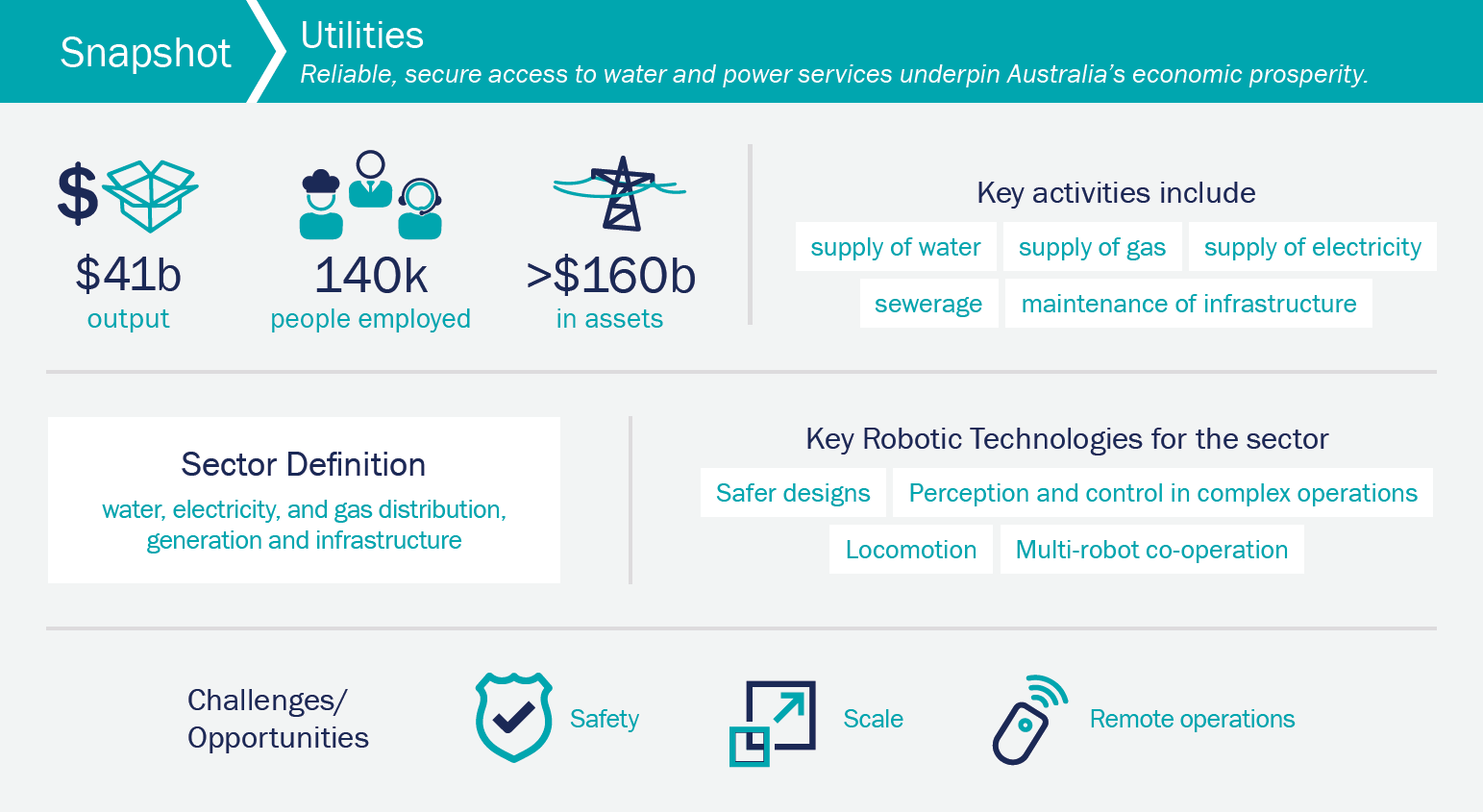
Utilities
The utilities sector encompasses essential services that underpin modern society, including electricity, gas, water, sewerage, and waste services. While often near invisible, this sector is vital to the ongoing success of all other sectors of the Australian economy.
Much of the utilities sector is run by government, or quasi-government owned organisations (state, regional or local depending on utility and location). However, with recent deregulation, some utilities are offered by private sector companies, notably in electricity and waste management. Utilities are worth $AU41 billion to the Australian economy (2.4 per cent of GDP) and employ approximately 140,000 people. The ratio of women to men in electricity, gas and water is 1:3.5, well below the average for the services sector (1:0.9) [WGEA16].
Electricity and gas supply are generally broken into a wholesale and a retail network, with downstream industries purchasing services at either, or both, levels. Domestic use is generally limited to purchasing utility services at a retail level, except in some rural locations.
Australia’s water assets are vast. The urban water industry provides enough drinking water to fill Sydney Harbour four times each year. It also uses 300,000 kilometres of water and wastewater pipes, enough to circle the earth six times. In July 2015, the value of Australia’s urban water assets was estimated to be $AU160 billion. Most of Australia’s water assets are publicly owned, the exception being the Sydney Desalination Plant which was designed and constructed under government ownership and then transferred to the private sector through a long-term lease in 2012 (EY-INF16).
The energy part of this sector is being disrupted by the advent of efficient solar (photovoltaic and other) and high-power density batteries (e.g., Tesla Powerwall for homes, plus the South Australian government’s big battery). This means end consumers can reduce reliance on energy networks provided by others for the generation of energy.

Robotics and utilities today
Australia has a vast network of critical infrastructure assets, required to deliver water and energy to homes and workplaces, and to remove waste. Australia’s electricity grid spans more than 5,000 kilometres and is one of the largest interconnected power systems in the world. Australia has more than 37,000 kilometres of natural gas transmission pipelines, transporting gas under high pressure. Sydney alone maintains more than 21,000 kilometres of water pipes, with 243 reservoirs and 150 water pumping stations. For wastewater there are more than 25,000 kilometres of pipes, 16 treatment plants, 14 recycling plants, and 677 wastewater pumping stations [SW18].
For a nation with a low population density, installing and maintaining services to remote (and even local) communities is an ongoing challenge. The work is often dangerous (at heights, energised), time critical, and occurs in remote and hard-to-access areas. This confluence of challenges is well-suited to solutions by robotic technologies. Opportunities include removing workers from high-risk activities, allowing remote unmanned operations, and increasing oversight of utility infrastructure and operations by having extra sets of “eyes” monitoring key resources and alerting or taking action when an issue is detected.
The future of robotics in utilities
The inspection and maintenance of Australia’s extensive network of infrastructure assets, managed by utility organisations, is critical for the maintenance of essential services. Robotic technologies have an important role to play in both inspection and maintenance, with the potential for a broader range of applications currently being explored.
Some applications of these technologies include:
- autonomous pipe and cable inspection
- autonomous installation/connection of pipes and cables
- autonomous construction of new assets (particularly in remote areas)
- physical support of field workers and autodetection of risks
- remote repair and refurbishment of assets
- maintaining physical security of assets via unmanned security patrols
- robotic solar collectors (aligning to perfect position, and location, for maximum efficiency)
- robotic water purifiers deployable after major weather events.
Main findings for robotics in utilities
Reliable, secure access to water and power services underpin Australia’s economic prosperity. Australia has a vast network of critical infrastructure assets required to deliver water and energy to our homes and workplaces and to remove waste. Our electricity grid spans more than 5,000km and is one of the largest interconnected power systems in the world. Australia has more than 37,000km of natural gas transmission pipelines, transporting gas under high pressure. Sydney alone maintains more the 21,000 km of water pipes. For a nation with a low population density, installing and maintaining services to remote (and even local) communities is an ongoing challenge. The work is often dangerous (at heights, energised), time critical and in remote and hard to access areas. This confluence of challenges is well-suited to solution by robotic technologies by removing workers from high risk activities, allowing remote unmanned operations and increasing oversight of utility infrastructure and operations by having extra sets of “eyes” monitoring key resources and alerting or taking action when an issue is detected.
